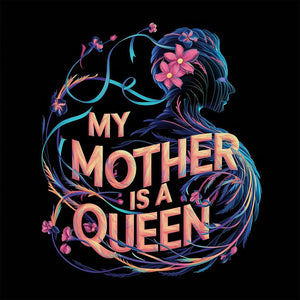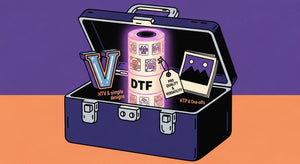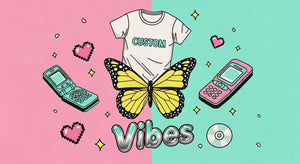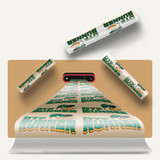Table of Contents
Heat Transfer Vinyl (HTV) is a popular choice in the world of custom printing for vivid, long-lasting designs. But, you have to think about how HTV complements others methods like DTF prints. In this light, I would like to delve into the advantages and disadvantages of using HTV when custom printing so you can understand better how each approach works. If you know about their difference, then you can take decisions easily which one is going best for your custom printing needs.
What is HTV?
Heat Transfer Vinyl, better known as HTV, is a special type of vinyl that can adhesive to fabric. The general idea is that you cut whatever design out of a sheet of vinyl and then press it into fabric with heat and pressure. There are lot of HTV, through this custom T-shirts, bags, hat etc. creates.
Advantages of HTV
1. Ease of Use
One of the major advantages that HTV offers is that, it is easy to use. You can create custom designs at home nearly instantly with a few basic tools like a vinyl cutter and heat press. It is still beginner-friendly and available for small businesses who don't want to invest their wages in large machinery. Applying HTV is a relatively easy process and doesn't require years of training, making it achievable for someone just starting out with custom printing to reach professional results.
2. Variety of Finishes
HTV also comes in an assortment of colors, finishes & textures. With options of experimenting with matte finish and glossy shine, glitter or metallic. It gives you a lot of options, and helps to keep things versatile so you can achieve different styles and looks. HTV can be as small or as large as you want depending on if your goal is a tiny discreet emblem, or a huge statement logo.
3. Durability
HTV (iron on vinyl) designs last a long time As long as it is done correctly, and your htv won't fade or wash off after multiple time of washing. So the fabric is actually rather good for things like clothes, which are worn and washed a lot. HTV is durable enough to make sure your custom designs look just as great as the quality of the shirt!
4. Cost-Effective for Small Runs
HTV is a good option for small quantities and basic designs. HTV is desirable in that instead of having to setup screens for each color like you do with screen printing, you can create designs without a lot of setup cost. As such, this is the ideal thing: It's a cheap way to produce and customize fabric without any expensive outcome for small businesses!
Disadvantages of HTV
1. Limited to Solid Colors
Yes, HTV comes in too many colors and finishes to count — but you can only get it as a solid color. However, it can be a cause of division if you have complex and multicolor designs due to the DTF print or any other printing methods through paper. However, HTV is not suitable for designs that require intricate color gradations or the photographic quality of a design.
2. Time-Consuming for Large Orders
It can take a while to weed and cut HTV designs, especially on large orders. These would all need to be cut and weeded which especially for multiple design orders can become very time consuming and slow down the productivity a great deal. This could present a substantial downside to businesses that need to manufacturer triggered by plenty of personalized products inside a short time period. And this is the place where DTF Runner gives you hand.
3. Requires Specialized Equipment
HTV requires a vinyl cutter and a heat press. Though these are not that costly, they mean further expense on your end and not everyone has the capacity, particularly the enthusiast of a startup. Some beginners who are interested in custom printing may find the upfront investment in equipment to be too expensive.
4. Less Detailed Designs
For small and simple designs, you will be fine with HTV. HTV would make them too expressive, so if the fine lines of gradations in design are important than it is important to adjust that. More intricate and complex designs can be produced using DTF prints or other printing methods. This obviously will limit what you can do in term of details, since HTV is not great for getting really fine intricate detail results.
Comparing HTV and DTF Prints
What are DTF Prints?
Direct-to-Film (DTF) printing is a form of graphic design process where the finalized designs are printed on the special film using digital print and then eventually by use of heat press, those film-printed designs get applied to clothes. The process is capable of producing durable and versatile prints with high-quality, detailed vibrant results. DTF prints are different and have their own set of pros and cons compared to HTV but, can also be used in a variety of custom printing projects.
Advantages of DTF Prints
-
High-Quality Prints: In addition to being highly detailed and colorful, DTF printed tees are great at replicating point of sales for how they feel. The quality of the DTF prints is quite similar to traditional and digital screen printing. This is why DTF would be the top choice for anything in need of photo detail and high resolution.
-
Versatility: You can use DTF prints on everything from cotton, polyester, to the blended fabrics. This creates the great way to DTF prints in custom printing projects. Whether you use t-shirts, hoodies or any other type of apparel, DTF prints can be optimized in terms of material.
-
No Weeding Required: DTF prints do not need to be weeded like HTV. This saves labour and time, especially in complex designs. If the weeding step is out of it this will definitely make the whole prodection process faster and smoother.
-
Suitable for Large Orders: This would help on both small orders and well as large orders. DTF prints are structured to assume the same turnaround time without any compromises in quality even with severe bulk. This has the effect of making DTF competitive as a viable solution for businesses looking to produce personalized items at high-volume. Utilizing tools like a gang sheet builder can further enhance efficiency for DTF prints.
Disadvantages of DTF Prints
-
Higher Initial Costs: While DTF prints come at a higher setup cost than HTV. They can be an expensive investment for small businesses or people who just need a couple of transfer prints. People may find it difficult to afford the tools and equipment needed.
-
Learning Curve: The learning curve for DTF printing is also higher than HTV. While the beginners may find it to be a true barrier for only trained and seasoned persons can deliver leads in the most elusive form. As with any printing process, DTF takes practice to master in order to achieve quality results.
-
Equipment Maintenance: In case of DTF printers, the regular maintenance is recommended to maintain print quality. It involves activities such as cleaning print heads and ink level management; which can be a cumbersome process leading to operational costs. Routine maintenance head off trouble and provides equipment longevity.
Combining HTV and DTF Prints
Combining HTV and DTF prints will create one-of-a-kind designs This way we will combine and maximize the merits of both methods in order to create really stand out custom clothing.
Step-by-Step Guide to Combining HTV and DTF Prints
-
Design Preparation: Design your sublimation design in graphic design software. Divide Items Into DTF and HTV Categories.
-
Printing the DTF Transfer: Transfer the DTF portion of your artwork to the film. This keeps the saturation and details of the image on point.
-
Cutting the HTV: Here is the HTV elements that are done being cut with a vinyl cutter. Weed the extra vinyl, leaving the design.
-
Layering and Pressing: Place the DTF transfer on the t-shirt and then press it, to finish it based on the tutorial. Then, place the HTV elements & press on top of applied DTF transfer.
Tips for Best Results
Choosing the Right Materials
- Quality DTF Film: Be sure to choose high-quality DTF transfer film color, even if you decide to use DTF cheap alternatives, as substandard films may experience peeling and fading.
- High-Quality HTV: Choose an HTV which is reputed for being long-lasting and tacky.
Proper Heat Press Settings
- Temperature: You must abide by the recommended heat settings of DTF and HTV materials alike.
- Pressure: Ensure the heat press applies even pressure across the design.
- Time: Stick to the pressing times recommended for each material.
Conclusion: DTF Prints vs. HTV
HTV and DTF prints each come with their pros and cons in the world of custom printing. HTV transfers come in a wide array of finishes, are perfect for small jobs and super easy to use. But, of course there are cons — like it being for solid colors only and somewhat labor-intensive on larger orders. DTF prints, on the other hand, offer vivid and detailed designs that can be applied on nearly any fabric but require a steeper learning curve and have higher upfront costs. For those considering DTF, uploading designs for gang sheets can be a cost-effective solution for multiple prints.
Understanding the differences can help you decide which of the tools you will use and work best for your custom printing needs. In fact, to be more creative with hot trends in special designs you can even use a combination of HTV and DTF print. For the hobbyist that wants to compete with the big boys and hopefully make a splash in their local custom apparel market, let's take a look at your strengths of both HTV and DTF. If you follow this article word by word, hopefully you will sure achieve success in your business.







